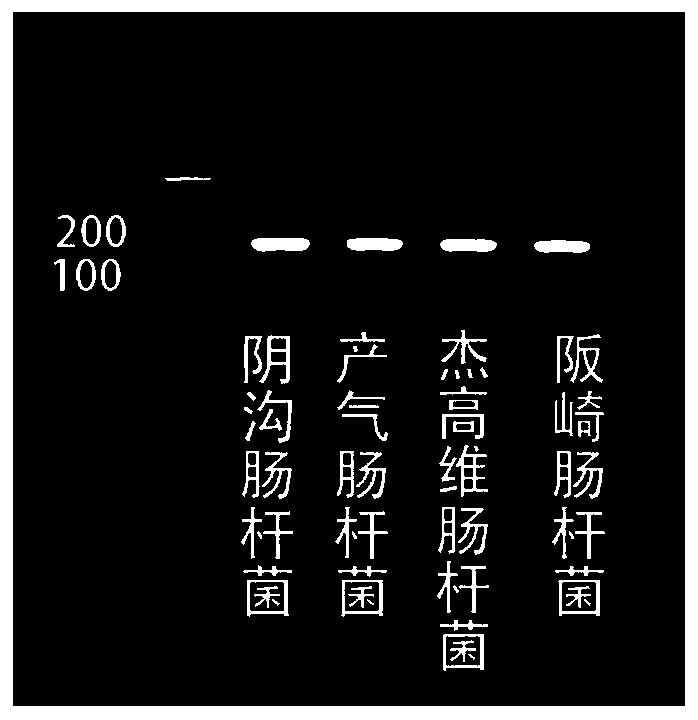A kit for detecting Enterobacter cloacae
A technology of Enterobacter cloacae and a kit, which is applied in the field of kits for the detection of Enterobacter cloacae, can solve the problems of high cost, delay in disease treatment, and inability to distinguish Enterobacter cloacae from other Enterobacter genus bacteria, and achieve low equipment requirements, highly specific effect
- Summary
- Abstract
- Description
- Claims
- Application Information
AI Technical Summary
Problems solved by technology
Method used
Image
Examples
Embodiment 1
[0014] Example 1: Sequence Alignment of the rpoB Gene of Enterobacter Bacteria
[0015] Such as figure 1 As shown, in the rpoB gene sequence of Enterobacter cloacae, the 5' end of the guide RNA sequence (selected part) of the present invention is the PAM structure of TTTN. The guide RNA sequence does not have a completely consistent sequence among Enterobacter aerogenes, Enterobacter Jagovii, and Enterobacter sakazakii, but there are several base differences. Moreover, there is no PAM structure of TTTN at the 5' end of the homologous sequences in Enterobacter aerogenes, Enterobacter Jagovii, and Enterobacter sakazakii. Therefore, using this guide RNA, the Cas12a protein cannot be targeted to Enterobacter aerogenes, Enterobacter aerogenes, and Enterobacter sakazakii. Enterobacter jagovius and Enterobacter sakazakii, therefore, only Enterobacter cloacae can show a positive reaction during the test, and the rest of the Enterobacter genus bacteria can show a negative reaction, wh...
Embodiment 2
[0016] Embodiment 2: The guide RNA specificity determination of the present invention, the steps are as follows:
[0017] (1) Prepare standard strains of Enterobacter cloacae, Enterobacter aerogenes, Enterobacter Jagovius, and Enterobacter sakazakii;
[0018] (2) Take 1ml of the sample to be tested, heat it at 98 degrees Celsius for 5min, and draw 1μl as the test sample;
[0019] (3) Prepare the reaction system, the reaction system is 25 μl, including 1 μl detection sample, 14.75 μl hydrated TwistAmpbasickit reaction drying ball (TwistDx company), 0.9 μl 10mM RPA-F (sequence is SEQ No.2) and RPA-R (sequence (SEQ No.3), 0.375 μl Ribonuclease Inhibitor (Takara Company), 3.5 μl buffer2.1 (NEB Company), 1000 nM guide RNA (sequence is SEQ No.1), 250 nM Cas12a (NEB Company), 200 nM single-stranded DNA probe Needle (Shanghai Sangong), add water to make up to 25μl;
[0020] (4) React at a constant temperature of 37 degrees Celsius for 30 minutes;
[0021] (5) After the reaction, pl...
Embodiment 3
[0023] Embodiment 3: the detection method based on guide RNA described in the present invention and traditional PCR method specificity and experimental time-consuming comparison
[0024] 1. based on the detection method of guide RNA described in the present invention, the steps are as follows:
[0025] (1) Prepare standard strains of Enterobacter cloacae, Enterobacter aerogenes, Enterobacter Jagovius, and Enterobacter sakazakii;
[0026] (2) Take 1ml of the sample to be tested, heat it at 98 degrees Celsius for 5min, and draw 1μl as the test sample;
[0027] (3) Prepare the reaction system, the reaction system is 25 μl, including 1 μl detection sample, 14.75 μl hydrated TwistAmpbasickit reaction drying ball (TwistDx company), 0.9 μl 10mM RPA-F (sequence is SEQ No.2) and RPA-R (sequence (SEQ No.3), 0.375 μl Ribonuclease Inhibitor (Takara Company), 3.5 μl buffer2.1 (NEB Company), 1000 nM guide RNA (sequence is SEQ No.1), 250 nM Cas12a (NEB Company), 200 nM single-stranded DNA p...
PUM
 Login to View More
Login to View More Abstract
Description
Claims
Application Information
 Login to View More
Login to View More - R&D
- Intellectual Property
- Life Sciences
- Materials
- Tech Scout
- Unparalleled Data Quality
- Higher Quality Content
- 60% Fewer Hallucinations
Browse by: Latest US Patents, China's latest patents, Technical Efficacy Thesaurus, Application Domain, Technology Topic, Popular Technical Reports.
© 2025 PatSnap. All rights reserved.Legal|Privacy policy|Modern Slavery Act Transparency Statement|Sitemap|About US| Contact US: help@patsnap.com



